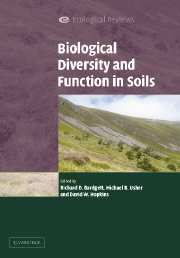Book contents
- Frontmatter
- Contents
- List of contributors
- Preface
- Acknowledgements
- PART I Introduction
- PART II The soil environment
- PART III Patterns and drivers of soil biodiversity
- 5 The use of model Pseudomonas fluorescens populations to study the causes and consequences of microbial diversity
- 6 Patterns and determinants of soil biological diversity
- 7 How plant communities influence decomposer communities
- 8 The balance between productivity and food web structure in soil ecosystems
- 9 Rhizosphere carbon flow: a driver of soil microbial diversity?
- PART IV Consequences of soil biodiversity
- PART V Applications of soil biodiversity
- PART VI Conclusion
- Index
- References
8 - The balance between productivity and food web structure in soil ecosystems
Published online by Cambridge University Press: 17 September 2009
- Frontmatter
- Contents
- List of contributors
- Preface
- Acknowledgements
- PART I Introduction
- PART II The soil environment
- PART III Patterns and drivers of soil biodiversity
- 5 The use of model Pseudomonas fluorescens populations to study the causes and consequences of microbial diversity
- 6 Patterns and determinants of soil biological diversity
- 7 How plant communities influence decomposer communities
- 8 The balance between productivity and food web structure in soil ecosystems
- 9 Rhizosphere carbon flow: a driver of soil microbial diversity?
- PART IV Consequences of soil biodiversity
- PART V Applications of soil biodiversity
- PART VI Conclusion
- Index
- References
Information
- Type
- Chapter
- Information
- Biological Diversity and Function in Soils , pp. 139 - 153Publisher: Cambridge University PressPrint publication year: 2005
References
Accessibility standard: Unknown
Why this information is here
This section outlines the accessibility features of this content - including support for screen readers, full keyboard navigation and high-contrast display options. This may not be relevant for you.Accessibility Information
- 10
- Cited by
